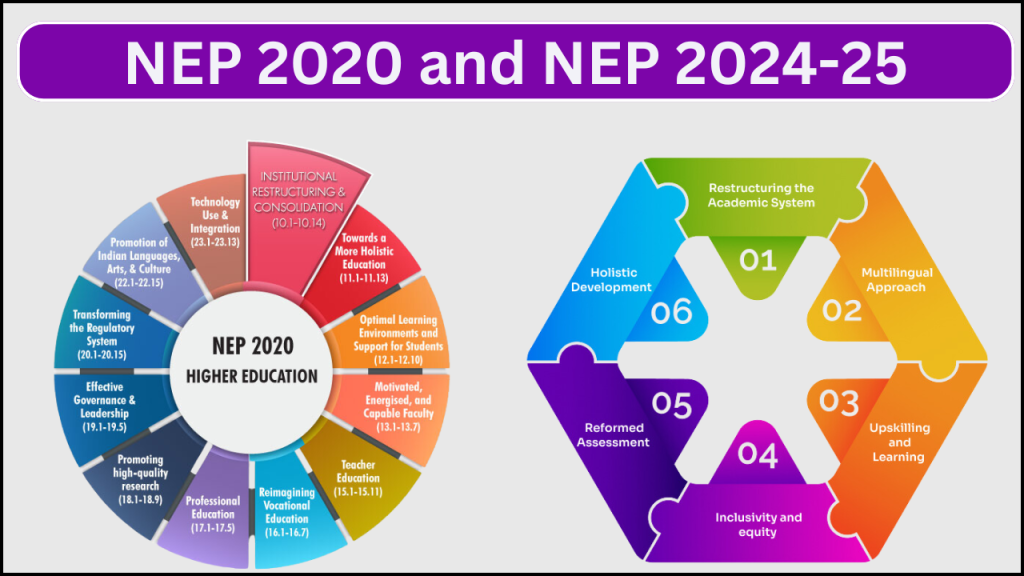
The National Education Policy (NEP) 2020 marked a significant shift in India’s educational landscape, introducing a comprehensive framework aimed at overhauling the system to meet 21st-century needs. Building upon this foundation, NEP 2024-25 has been introduced to address practical challenges and refine the initial vision based on feedback and evolving educational demands.
Key Differences Between NEP 2020 and NEP 2024-25
| Aspect | NEP 2020 | NEP 2024-25 |
|---|---|---|
| Policy Nature | Core policy document outlining a comprehensive vision for transforming India’s education system. | Implementation-focused, addressing practical challenges with updates and modifications based on feedback and ground realities. |
| Curriculum Flexibility | Emphasized multidisciplinary and holistic education. | Further emphasizes flexibility, integration of technology, vocational training, and a shift towards skill-based education. |
| Technology Integration | Advocated for the use of technology in education. | Strong focus on setting up tech-enabled classrooms and digital e-learning infrastructure. |
| Vocational Training | Introduced vocational education from Grade 6. | Continues emphasis on vocational training with a focus on skill development aligned with industry needs. |
| Implementation Approach | Phased implementation over several years. | Ongoing phased approach with annual updates to align with evolving educational needs. |
NEP 2020 laid the groundwork for a transformative educational framework, emphasizing inclusivity, critical thinking, and holistic development. NEP 2024-25 builds upon this by focusing on practical implementation, addressing challenges, and introducing updates to ensure the policy remains relevant and effective. This evolution reflects a commitment to continuously adapt and improve India’s education system to meet contemporary demands.
1. Structural Changes in School Education:
- Transition from 10+2 to 5+3+3+4 Structure: NEP 2024-25 replaces the traditional 10+2 system with a 5+3+3+4 model, aligning educational stages with children’s developmental needs:
- Foundational Stage (Ages 3-8): Comprises three years of pre-primary education followed by Grades 1 and 2, focusing on play-based and activity-based learning.Preparatory Stage (Ages 8-11): Includes Grades 3 to 5, emphasizing foundational literacy and numeracy skills through experiential learning.Middle Stage (Ages 11-14): Covers Grades 6 to 8, introducing a subject-oriented approach encompassing sciences, mathematics, arts, social sciences, and humanities.Secondary Stage (Ages 14-18): Encompasses Grades 9 to 12, offering greater flexibility and subject choices, eliminating rigid stream divisions to deepen subject understanding and prepare students for higher education and vocational paths
2. Examination Reforms:
- Flexible Board Examinations: To reduce student stress, NEP 2024-25 allows board examinations to be taken twice a year, enabling students to retain their best scores.
3. Enhanced Focus on Digital Integration:
- Technology-Driven Education: NEP 2024-25 emphasizes integrating technology into education, promoting digital literacy, and preparing students for a tech-driven future.
4. Inclusivity and Regional Language Priority:
- Multilingual Education: The policy promotes regional languages in education, ensuring inclusivity and catering to India’s diverse linguistic landscape.
5. Governance and Regulatory Reforms:
- Establishment of the Higher Education Commission of India (HECI): NEP 2024-25 proposes consolidating multiple regulatory bodies into HECI to streamline governance and enhance accountability in higher education.
6. Implementation Status:
- Progress Since NEP 2020: As of December 2024-25, significant strides include the abolition of the ‘No Detention Policy’ for Classes 5 and 8, introduction of the four-year undergraduate program in over 105 universities, and offering engineering and medical courses in regional languages.
In summary, while NEP 2020 laid the visionary groundwork for educational transformation in India, NEP 2024-25 builds upon this by introducing practical reforms focused on structural changes, examination flexibility, digital integration, inclusivity, and streamlined governance to address emerging challenges and further enhance the education system.